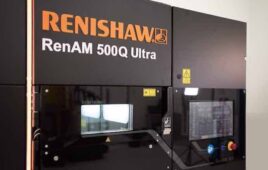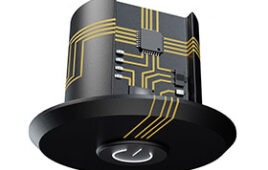
The main match of the night was about to begin. The announcer began to warm up the restless crowd with a little trash talk.
In the red square, this bot is like Superman. His girlfriend is Lois Pain. And you’re about to be Clark Dent. Here he comes to slay the day! It’s Captain Shrederator!
This ringmaster’s spiel typifies a lot of the antics that go on during BattleBots, which seem to be backstories TV wrestling but without the soap-opera back stories.
BattleBots is a competition where teams compete for the distinction of fielding the top battling robot. After a hiatus from TV of several years, BattleBots can now be seen on the Discovery and Science channels. This new generation of hardware is a far cry from earlier backyard-mechanic-style bots. “Back in the day, BattleBots was more of a science fair/art show/sculpture/nerd-fest event,” says BattleBots co-founder and producer Greg Munson. “It was a lot of fun but only the master designers were bringing competitive robots that could do real damage. As the sport has evolved, designs have gotten more complex.”
They’ve also gotten more dangerous, thanks partly to the availability of battle spaces that are better funded. One of the most successful bots from the 1990s was designed by Jamie Hyneman of Mythbusters fame. Called Blendo, it was a full-body kinetic energy spinner weapon with a shell made from a wok. Powered by a lawnmower engine, blades attached to the shell tended to remove the bodywork of opponent robots and in some instances threw them over safety shields into the crowd.
“Blendo was so dangerous that (Robot Wars creator) Marc Thorpe had to ban it from the competition because he didn’t have an arena strong enough to protect the audience,” says Munson. “People saw that design and took a page out of the Blendo book. Ziggo was a lightweight full-body spinner that did real damage to the other lightweights, it just turned them into scrap. Then Tony Buchignani built a robot called Hazard which had a bar spinner mounted on top like a helicopter.”
The current generation of battling robots evolved from these early efforts. Bot weapons now include not just horizontal full-body and bar spinners, but also disk spinners, both vertical and horizontal spinners, and even bots with multiple spinners. Besides spinners, robot designs have evolved into wedges, lifters, and grapplers. “Creativity and the engineering mindset takes over in the design of modern bots, distilling things down to their most pure forms that can survive and win a competition,” says Munson.
The rules of BattleBots dictate that every bot must have a weapon, but there are few formal restrictions on what constitutes a weapon. So you might wonder what prevents a team from just mounting an AR-15 on wheels and sending it out to do battle.
The answer is a vetting process instituted by the BattleBots producers. “In the early days of BattleBots, the rulebook was about 50 pages,” says Munson. “We tried to think of every scenario we didn’t want and made it illegal. But we rethought that whole process. We wanted the rules to be as simple as possible because we wanted people to be super creative. Now we make teams fill out an application and a team of engineering safety experts must bless it before it’s allowed. In some cases weapons such as flamethrowers have to be tested beforehand to make sure they can’t hurt the audience. Those types of weapons would have been totally impossible in the old BattleBot days.”
The bots that make the cut for televised bouts tend to be relatively sophisticated designs that aren’t exactly cheap to construct. Most teams have more than $10,000 invested in their hardware, and some spend upwards of $30,000 or more. And the rewards for winning a fight are mainly bragging rights.
“Winners get prize money, but we try to keep things as egalitarian as possible,” says Munson. “There’s a prize money pool that slowly escalates through the rounds. It is not a lot, but what they get helps when they leave the event with seven burned out motors, destroyed speed controllers, and batteries that have exploded.”

Team Huge consists of (from left) Peter Lombardo, Maddie Thumma, Jonathan Schultz, Garrett Santoline, and (not shown) Alex Horne. Schultz and Lombardo credit Huge’s durability to use of redundant components and a design ethic where components are packed in a cushioning package. (Credit: 2018 BattleBots Inc./Daniel Longmire)
Inside a BattleBot
Icewave is a heavyweight robot whose main feature is a 15-hp internal combustion engine (hence “Ice”) with a light-weight magnesium block originally from a concrete saw. The engine sits on top of the robot and powers a 54-in. spinning steel bar usually weighing 47 lb with its blade tips spinning at about 300 MPH.
Icewave team captain Marc DeVidts, who has been building battle bots since he was 17, says the process for creating a battling robot is different than what typically goes on during conventional product design. “If you can build a battle bot, you can build pretty much anything to survive the real world. But a more conventional product is designed to balance factors such as cost, weight, durability, and similar parameters. You don’t normally think about those things with a bot because you’re just throwing a machine into an arena for three minutes,” says DeVidts. “In the real world, you might do simulations before you actually build anything. But I laugh at the people that try to do simulations in BattleBots because they have so many unknowns. It would be quite complicated to figure it all out and it would be different for every robot that you’re fighting.”
The fact that even winning bots take brutal beatings in matches leads most teams to use simple components that are easily replaced. Icewave is a good example of that philosophy. “Most bots are what we call tank drive, meaning that the left and right wheels are separate controllers,” says DeVidts. “Almost all bot drive motors are just dc brush motors. The brush motors we use are about three inches in diameter and about six inches long, putting out about 2.5 hp each. You’ll see something bigger if the robot is geared toward pushing people around. Because we don’t really intend to push people too much, we don’t have one of the more powerful drivetrains. Two or three companies cater to making the kinds of drive motors you see in the bots. They are really a different class of motor. They’re literally meant to run for three minutes and burn out.”
Most drive motors run open loop. “Very few robots do closed-loop control, either position or speed. It’s mostly just open loop and we just drive it with current – give it this much current and you go this speed. The speed controllers are usually the same as those used to fly quadcopters. They generally all use some kind of proprietary communication protocol up in the 2.4 GHz band,” DeVidts says.
The simple design philosophy of Icewave extends to the use of batteries. “Most people use lithium-polymer batteries because of their high energy density. But some teams use the cylindrical cells because, they’re a little more reliable and can handle the heat better. But, if you really want to just get the most out of a small amount of weight and space, you go with the LiPo packs,” says DeVidts. “Part of the appeal of the Icewave design was that we don’t need a lot of batteries – the spinner motor runs on gas. Back in 2005, that was really appealing because batteries were super-expensive.”

Valkyrie robot. Copyright 2018 BattleBots inc. Photo by Daniel Longmire
Valkyrie is No Norse Myth
Valkyrie is a heavyweight robot armed with an undercutting flywheel which can be exchanged for a spinning bar. The team is led by Leanne Cushing who got hooked on robots when on her high school FIRST robotics team. “I did an assembly that solved a problem and six weeks later saw it work, and it worked the way I saw it in my head. That was the point I decided, yup, I’m doing this for life,” she says.
Cushing says the Valkyrie design was proposed by a teammate. “We white-boarded every weapon option that would have potential for doing well and hadn’t been seen in the new show. The first month and a half was spent doing aerodynamic theory. We did smaller versions of the robot as prototypes with roughly the same ratios of weapon weight and full system weight, trying to maximize the (weapon) diameter,” she explains.
Cushing also did some dry runs in other robot competitions to “see how the team handles pressure and whether there are any conflicts,” she says. “You can assemble a team that you think is great but then under pressure and deadlines, someone has a beef with somebody else, or someone doesn’t pull their weight, or someone buckles under stress. “
As with the Icewave bot, Valkyrie is many a product of trial and error. “The only thing we simulated was the weapon blade because we couldn’t really test one for a weapon this size. They behave differently when they get bigger and the amount of force they swing is different,” Cushing says.
Cushing also thinks younger engineers have a mindset that tends toward trial-and-error methods. ” My generation thinks and builds significantly differently than engineers two or three generations before us. We have the ability to do rapid prototyping with water jet cutters and 3D printers rather than sitting around doing simulations and analysis for a couple weeks. Why sit around wondering when you can fabricate it in four hours and just do it?” she says. “But once you have a lot of dollars at risk for the final version, then you make sure the theory does line up with your testing.”

Valkyrie leader Leanne Cushing and the rest of her team. The bot features a flywheel-style weapon that sits close to the floor. Cushing explains that the key component that makes the weapon practical is a compact custom-designed clutch. Commercial versions would force the flywheel to sit too high off the ground to be effective. (Credit: 2018 BattleBots inc. Photo by Daniel Longmire)
A “Yuge” Bot
Huge is a white, box-shaped robot with giant ultra-high-molecular-weight-polyethylene wheels. Its weaponry consists of a powerful pair of spinning bars oriented vertically. Visually, the effect is a little like seeing a civil war cannon painted white. Team leader Jonathan Schultz says it was difficult to fabricate the wheels from a single piece of plastic, but the approach has paid dividends. “It’s more robust than doing it out of a bunch of little pieces,” Schultz says. “The wheels are not springy. They don’t bounce, and you can’t even really bend them by hand. On TV, they look flexible because of the forces thrown around during a match.
Huge is actually constructed as two mirrored halves. “There’s two weapons, one on either side. So there are also four brush motors, two for powering axles, two for powering the spinning blades. Everything is self-contained. So there are also four on/off switches, four sets of batteries, four radio receivers, and four controllers for the motors,” says Schultz.

Huge robot under construction. (Credit: 2018 BattleBots Inc/Daniel Longmire)
He says this redundancy is key for designing a bot that can survive a match. “There are a lot of teams that just built one control head. If the receiver breaks, then the entire robot is dead because of one $20 piece of plastic. That’s what usually has happened when you see a robot take two hits and just crap out. But if one of our systems go down we still have the other three motors, so we keep fighting. BattleBots mandates separate switches for weapons and the drive, but a lot of people only use one radio receiver and that is a single failure point.”
As in other bots with spinning weapons, clutch design turned out to be another key factor in the success of Huge. “We have to be mindful of energy and horsepower. You can pack however many kilojoules of energy into the bar. But half of it goes into the opponent, half of it reflects back into you, so you have to have a plan for that,” says Schultz. “We have a V-belt drive system configured with a clutch such that any impulse going through the system hard should slip the belt. But I don’t initially think we totally understood the forces that were there. Testing gives you so much more information than anything you can envision.
I think our design survived because the entire motor was shock-mounted in rubber. There’s nothing off-the-shelf in the world that could take the forces involved so every piece of electronics is wrapped in foam and tape, every connector is tightly closed, and every motor is mounted softly in place.”
There’s one last thing you can say about BattleBot matches: You’re unlikely to see the kind of sullen post-match interview that sometimes happens in the locker rooms of teams that have just lost a Super Bowl. More typical are the comments of Ed Robinson, team leader for a bot called Sharkoprion, after a lopsided loss to a grappling bot: “That was epic, that was fun! That was the most fun I’ve had in 55 years!”
Just think what Robinson would have said if his team had won.
Filed Under: 3D printing • additive • stereolithography, The Robot Report





I read the rules, the fastest external part on a robot is 370 feet per second which converts to 250mph. Why can ice waves weapon spin at 300mph?
Has anyone tried to make a fully automatic. Not
Turn it on ant fights by itself..no external control except for off…